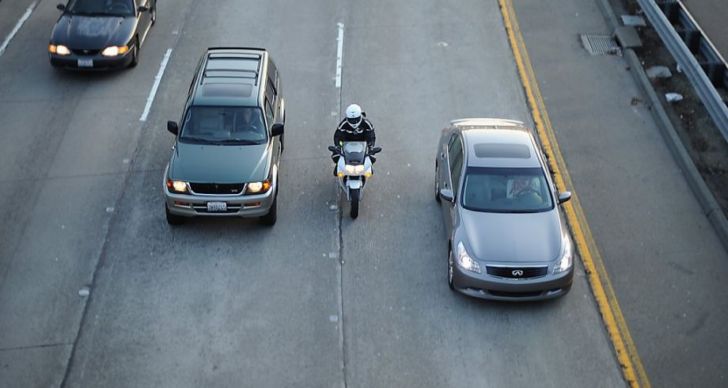California Highway Patrol (CHP) has revealed the conclusions of a year-long study on lane-splitting. The study says that splitting lanes is no more dangerous than simply riding a motorcycle, provided that the riders are obeying the general guidelines of lane-splitting.
Almost two years ago, the CHP had listed a set of lane-splitting guidelines on their website, aimed at helping both riders and other motorists understand traffic better and make it safer. They referred mostly to the speed when splitting lanes and checking before changing direction.
2. If traffic moves at more than 30 mph (48 km/h), you should not split lanes
3. It's safer to split lanes 1 and 2
4. Look around you carefully before deciding to split lanes
5. Keep in mind that other road users might not be aware of you coming between the lanes.
However, the CHP was forced to take them down after a citizen filed a complaint stating that those recommendations could be interpreted as a law-making action. And since the role of the CHP is to uphold the law and not make it, the smart CHP fellows that seemed to understand motorcycle better than others had to remove these guidelines.
It’s easy to figure out that the amount of collected data is very consistent and it will be the source of more detailed conclusions in the future. Still, the first results after sorting out through the data reveal that there is not enough evidence to claim that splitting lanes is any more dangerous than riding a motorcycle in any other circumstances, when the recommended speed limits are obeyed.
Like it was expected, the study showed that motorcyclists who split lanes are less likely to be rear-ended by other vehicles, while they are however, prone to rear-ending other motorists. Further analysis is expected to reveal more comprehensive, quantized data regarding road conditions, types of motorcycles, rider age and gender, the speed of the vehicles involved in a collision and more. The final goal of CHP’s study is as mentioned, to provide scientific proves to demonstrate the correlation between riding behavior and the crashes involving motorcycles.
The number of motorcyclists splitting lanes is on the rise. Around 62 percent of riders say they split lanes, a 7.5% increase over the same figure of 2013, the Sacramento Bee says.
Is this the first solid move towards trying to make lane-splitting legal on a wider scale? We certainly do hope so!
The guidelines were summed to the 5 pieces of advice listed below:
1. If you split lanes, make sure you ride no more than 10 mph faster than the traffic (16 km/h)2. If traffic moves at more than 30 mph (48 km/h), you should not split lanes
3. It's safer to split lanes 1 and 2
4. Look around you carefully before deciding to split lanes
5. Keep in mind that other road users might not be aware of you coming between the lanes.
However, the CHP was forced to take them down after a citizen filed a complaint stating that those recommendations could be interpreted as a law-making action. And since the role of the CHP is to uphold the law and not make it, the smart CHP fellows that seemed to understand motorcycle better than others had to remove these guidelines.
The study involved 8,262 motorcycle crashes
The California Highway Patrol wanted to have a more scientific, palpable backing for their lane-splitting support, so they asked 80 law enforcement agencies to fill in an additional sheet which each of the investigated cases.It’s easy to figure out that the amount of collected data is very consistent and it will be the source of more detailed conclusions in the future. Still, the first results after sorting out through the data reveal that there is not enough evidence to claim that splitting lanes is any more dangerous than riding a motorcycle in any other circumstances, when the recommended speed limits are obeyed.
Like it was expected, the study showed that motorcyclists who split lanes are less likely to be rear-ended by other vehicles, while they are however, prone to rear-ending other motorists. Further analysis is expected to reveal more comprehensive, quantized data regarding road conditions, types of motorcycles, rider age and gender, the speed of the vehicles involved in a collision and more. The final goal of CHP’s study is as mentioned, to provide scientific proves to demonstrate the correlation between riding behavior and the crashes involving motorcycles.
The number of motorcyclists splitting lanes is on the rise. Around 62 percent of riders say they split lanes, a 7.5% increase over the same figure of 2013, the Sacramento Bee says.
Is this the first solid move towards trying to make lane-splitting legal on a wider scale? We certainly do hope so!
